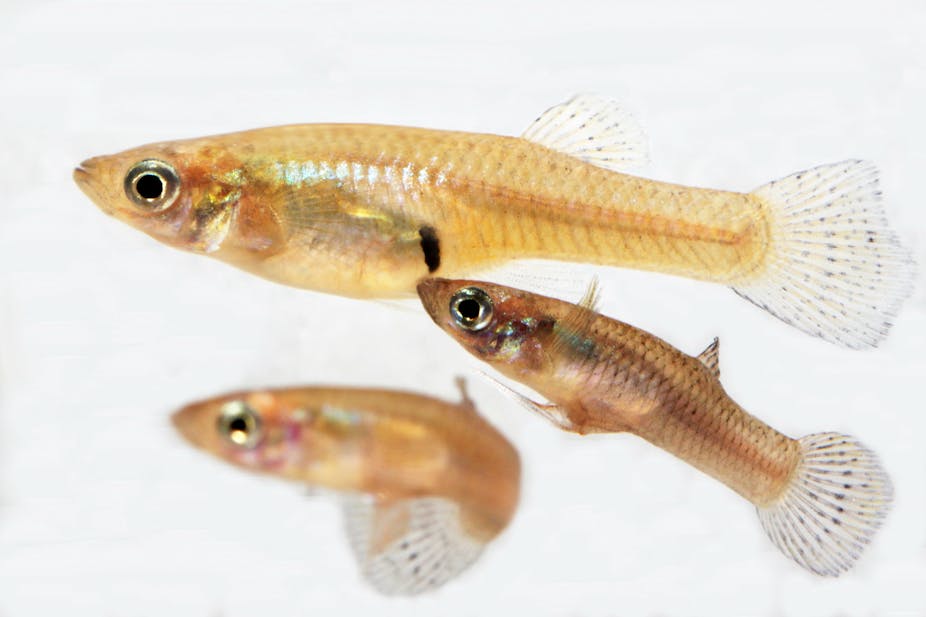“Finish your dinner or there’ll be no dessert for you!” – it’s a cry heard at dinner tables around the world, as mothers battle to convince their sons about the importance of eating properly. Sorry lads: mum’s right on this one.
A poor nutritional upbringing has been shown to have all sorts of long-term consequences in myriad species – humans included. And now, research by myself and colleagues at the Research School of Biology at ANU has shown that a good start to life can also make you more attractive to the ladies – if you’re a mosquitofish that is.
Playing catch-up
The natural world is a variable one – levels of available food rise and fall with the level of competition, the seasons change, the weather varies from day to day. In this way it’s not unusual for animals to face challenging conditions early in life.
How are these unlucky individuals meant to compete with their luckier rivals?
Well, one option to compensate for a bad start in life is to delay entry into a future developmental stage (that is, sexual maturity) until they are as big as their rivals. Alternatively, individuals might show compensatory growth – a dramatic increase in their growth rate when food does become available. This allows them to quickly catch up to where they should’ve been.
Costly compensation?
While it’s easy to see how such responses are favoured by natural selection, the existence of compensatory growth raises a big question: if animals can grow so fast when food is plentiful, why don’t they do it all the time?
One possible answer is that rapid growth actually imposes costs of its own – rapidly grown bones may be more fragile, for instance. Indeed, studies have found that compensatory growth negatively impacts a range of traits such as survival, longevity and fecundity (or fertility) in numerous species.
Thus, it only makes sense to grow this fast when you’re already lagging behind.
The question my colleagues and I asked was: does a poor start in life, followed by compensatory growth, affect adult sexual attractiveness?

Mosquitofish: from meals to mating
We studied this question in the introduced pest species mosquitofish (Gambusia holbrooki), a relative of guppies and swordtails.
In mosquitofish, males do not actively court females – instead they incessantly try to copulate coercively. So the closest a female can get to “choosing” her partner is to avoid males she doesn’t like the look of.
We separated pairs of brothers at birth and subjected one brother to a three-week period of severe food limitation before returning him to the continuous, abundant diet enjoyed throughout by his brother.
Males on the restricted diet displayed compensatory growth – but couldn’t completely catch up, so they also slightly delayed maturation. Therefore, on average, brothers reached the same final size and looked indistinguishable, at least to us.
Surprisingly though, when we gave females the choice between the two brothers, they were able to distinguish between the two and actively avoided the male who had suffered a bad start to life.
How and why?
Why would females shun these unfortunate males? Well, the possible reasons are two-fold. First, males that have suffered a period of poor nutrition may be more susceptible to parasites and diseases, which could be passed directly to the female if she got too close.
Second, perhaps a male’s ability to get enough food when he’s young is heritable in the wild. If this were the case, it would make sense for females to choose well-fed males because it would increase their offspring’s chances of feeding themselves.
So how do the females tell the males apart? Well, we don’t know that yet. We suspect it has something to do with locomotor ability – the way they swim. Compensatory growth has previously been shown to negatively impact swimming performance in a related species: the green swordtail.
Less than meets the eye
One of the more interesting aspects of our findings is that if you were to put a pair of males in a tank together, you wouldn’t be able to tell which one had undergone which feeding regime. But the female mosquitofish could.
This highlights an important lesson for those researching mate choice – animals’ ideas of attractiveness might often go beyond our simple proxies (body length, in the case of the mosquitofish).
Still, and this shouldn’t really come as a surprise, most individuals do have a “type”; but when it comes to picking a partner the most important thing is often a little chemistry and a touch of je ne sais quoi.

